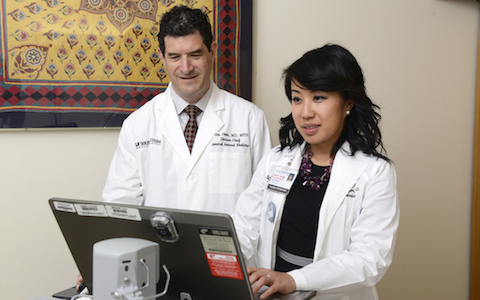Researchers find safety-net clinics are important options for minority, low-income populations, even those with health insurance coverage

DALLAS – March 31, 2016 – Safety-net clinics are likely to continue to play a critical role in meeting the needs of insured minority and low-income populations despite expanded insurance coverage under the Affordable Care Act (ACA), a study by UT Southwestern researchers suggests.
Based on results of federal government health care surveys from 2006 to 2010, the study showed that more than a third of all primary care visits to safety-net clinics were by adults with private insurance or Medicare, representing more than 6.6 million visits annually, researchers said.
The study appears in PLOS ONE, a peer-reviewed, multidisciplinary, open-access journal produced by the Public Library of Science (PLOS).
“Our study revealed that these individuals have a high burden of chronic illness such as diabetes and hypertension, and that they rely on safety-net clinics despite having what is typically considered ‘good’ insurance coverage,” said lead author Dr. Oanh Nguyen, Assistant Professor of Internal Medicine and Clinical Sciences at UT Southwestern. The strongest predictors of safety-net clinic use among adults with private insurance or Medicare were:
- Being from a high-poverty neighborhood.
- Being eligible for both Medicare and Medicaid.
- Being black or Hispanic.
Compared to users of health care facilities not defined as safety-net clinics, adults with insurance other than Medicaid who received care in safety-net clinics had a higher prevalence of diabetes, hypertension, multiple illnesses, and use of multiple medications.
Researchers also found that nearly one-third (28.9 percent) of Medicare beneficiaries in safety-net clinics were covered by Medicaid (i.e., “dually eligible”), compared with less than 7 percent of Medicare beneficiaries in non-safety-net clinics. Dually eligible beneficiaries are a subset of Medicare patients who typically have more complex health needs and higher health care use than other Medicare beneficiaries.
Safety-net clinics and hospitals provide care to individuals regardless of ability to pay, serving a critical role as providers of “last resort” for roughly 44 million uninsured and underserved Americans who are disproportionately minorities, immigrants, Medicaid beneficiaries, or persons living in disadvantaged communities. In contrast, individuals with private insurance or Medicare are generally thought to be less reliant on safety-net providers given their potential access to care in other settings.
“Many people are anticipating that newly insured individuals will choose to seek care elsewhere given broader insurance coverage under the ACA,” said study senior author Dr. Ethan A. Halm, Chief of the William T. and Gay F. Solomon Division of General Internal Medicine, and Chief of the Division of Outcomes and Health Services Research in the Department of Clinical Sciences at UT Southwestern. “However, our findings suggest this assumption may not necessarily be the case, since safety-net clinics were important outlets for certain insured populations even before ACA.”
Potential reasons for choosing safety-net health settings are comparative advantages in addressing unmet social needs – potential barriers such as language, culture, employment, and transportation – compared with non-safety-net providers, the researchers said.
Newly covered individuals are likely to have previously gone without care while uninsured, and have higher health care use after receiving insurance coverage. In addition, those with expanded insurance coverage who still find health care unaffordable due to high out-of-pocket costs may gravitate to the more affordable safety-net clinics, researchers said.
“We think that expanding coverage will not eliminate the important role that safety-net hospitals and clinics provide in caring for minority, low-income, and high-need individuals, irrespective of insurance type,” said Dr. Nguyen, “and that maintaining adequate support for a strong safety-net system, in addition to expanding insurance coverage, will be critical to ensuring access and addressing racial/ethnic and social class disparities in health care.”
The research is the first comprehensive national study assessing the role of the safety-net system in caring for non-Medicaid insured populations and assessing the potentially distinct characteristics and care needs of these individuals. Researchers examined data from 2006-2010 from the National Ambulatory Medical Care Surveys (NAMCS), an annual, nationally representative survey of ambulatory office visits administered by the National Center for Health Statistics (NCHS).
This work was supported by the UT Southwestern Center for Patient-Centered Outcomes Research, which is led by Dr. Halm, Professor of Internal Medicine and Clinical Sciences and holder of the Walter Family Distinguished Chair in Internal Medicine in Honor of Albert D. Roberts, M.D. Additional support came from the UT Southwestern KL2 Scholars Program. The Center, supported by a $5 million grant from the federal Agency for Healthcare Research and Quality, seeks to assess the benefits and harms of different preventive, diagnostic, therapeutic, and health delivery system interventions to inform decision-making, highlighting comparisons and outcomes that matter to people.
The Center works in conjunction with UT Southwestern's Center for Translational Medicine, part of a $28.6 million grant from the National Institutes of Health to promote rapid translation of basic laboratory findings into patient care. The Center for Translational Medicine is a member of a national Clinical and Translational Science Award Consortium that includes more than 60 medical research institutions.
Also contributing to this study from UT Southwestern was Dr. Anil Makam, Assistant Professor of Internal Medicine and Clinical Sciences.
About UT Southwestern Medical Center
UT Southwestern, one of the premier academic medical centers in the nation, integrates pioneering biomedical research with exceptional clinical care and education. The institution’s faculty includes many distinguished members, including six who have been awarded Nobel Prizes since 1985. The faculty of almost 2,800 is responsible for groundbreaking medical advances and is committed to translating science-driven research quickly to new clinical treatments. UT Southwestern physicians provide medical care in about 80 specialties to more than 100,000 hospitalized patients and oversee approximately 2.2 million outpatient visits a year.
###
Media Contact: Russell Rian
214-648-3404
russell.rian@utsouthwestern.edu
To automatically receive news releases from UT Southwestern via email, subscribe at www.utsouthwestern.edu/receivenews




